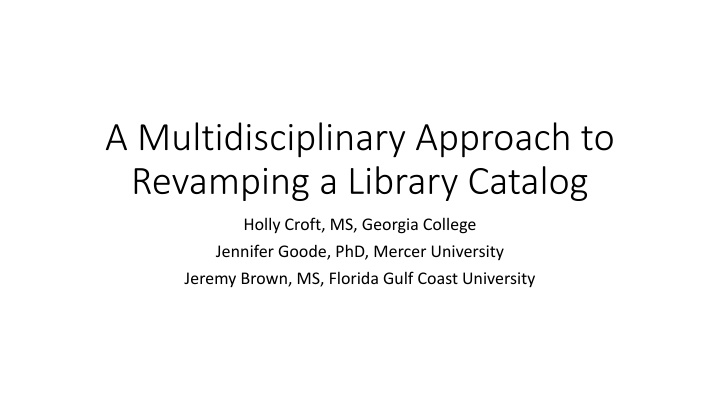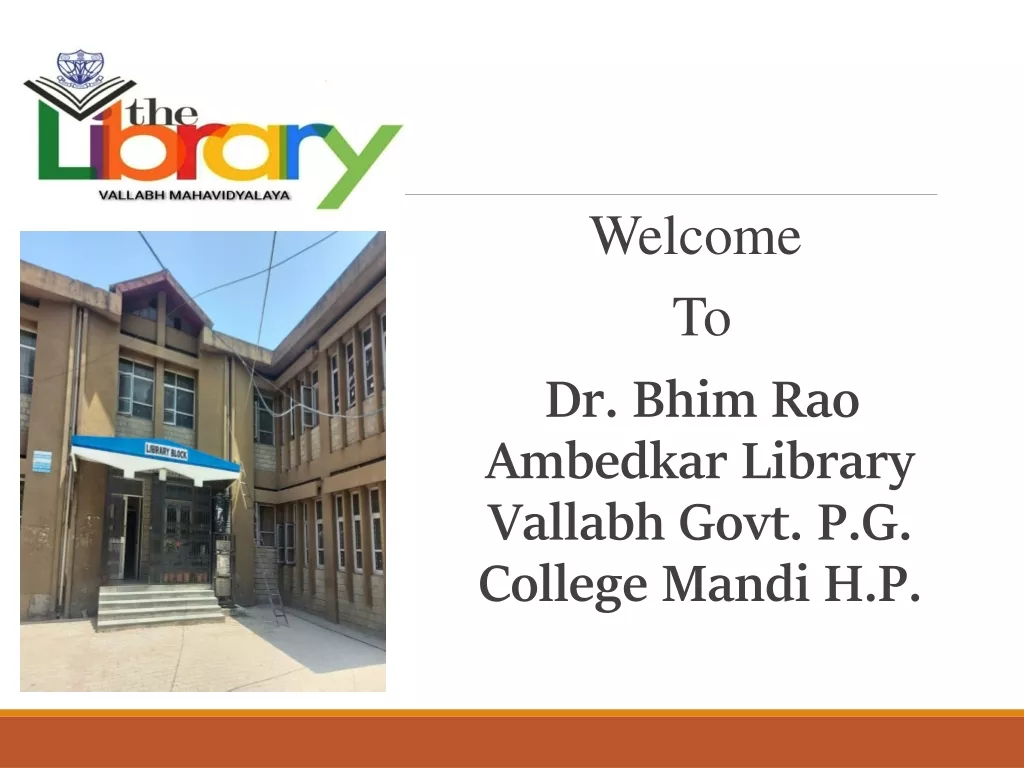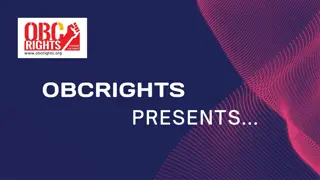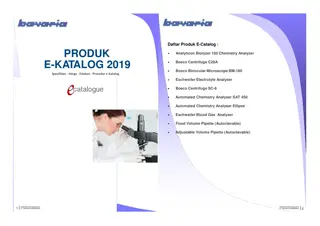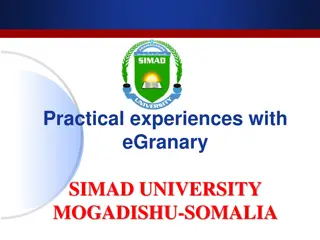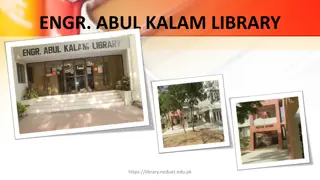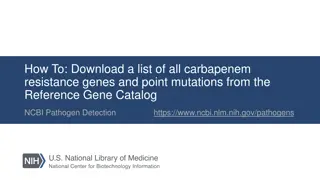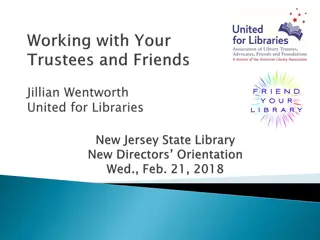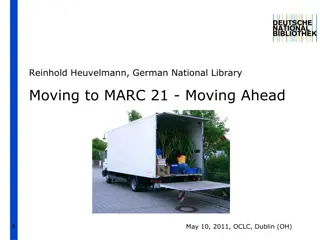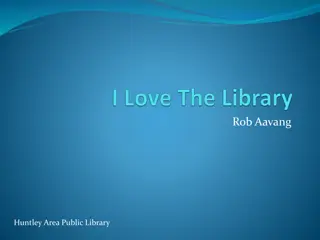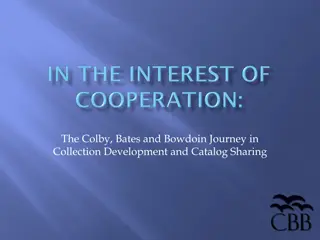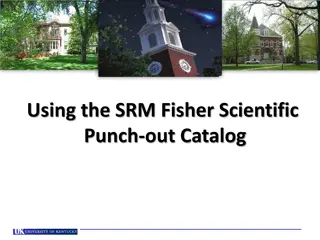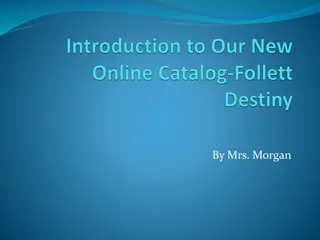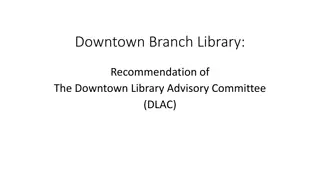A Multidisciplinary Approach to Revamping a Library Catalog
This presentation discusses the collaborative effort by a team of professionals to revamp a library catalog for the Georgia Department of Transportation's Roy A. Flynt Memorial Library. The project stemmed from a need for a better library catalog identified during discussions with GDOT employees. The team, comprising technical communicators, a digital archivist, and a systems librarian, worked together to enhance the library catalog's usability and accessibility. Through their multidisciplinary approach, they successfully updated the catalog, improving the search and retrieval process for users, particularly GDOT employees seeking research reports. The project highlights the importance of understanding users' needs and implementing innovative solutions in library services.
Download Presentation

Please find below an Image/Link to download the presentation.
The content on the website is provided AS IS for your information and personal use only. It may not be sold, licensed, or shared on other websites without obtaining consent from the author.If you encounter any issues during the download, it is possible that the publisher has removed the file from their server.
You are allowed to download the files provided on this website for personal or commercial use, subject to the condition that they are used lawfully. All files are the property of their respective owners.
The content on the website is provided AS IS for your information and personal use only. It may not be sold, licensed, or shared on other websites without obtaining consent from the author.
E N D
Presentation Transcript
A Multidisciplinary Approach to Revamping a Library Catalog Holly Croft, MS, Georgia College Jennifer Goode, PhD, Mercer University Jeremy Brown, MS, Florida Gulf Coast University
Roy A. Flynt Memorial Library The Roy A. Flynt Memorial Library is publicly accessible on the Georgia Department of Transportation s website. The most frequent users are GDOT employees who use the research reports to keep up to date on the latest research. They need these reports to be easily and quickly accessible.
The Problem On January 18, 2018, GDOT s Office of Performance-Based Management and Research put out a call for a project titled, Annotated GDOT R&D Bibliography. The call indicated that GDOT needed not only an annotated bibliography of its research reports, but also a new digital repository. Drs. Jennifer Goode and Pam Brewer from Mercer University submitted a statement of interest for the project and were invited to proceed with a research needs statement in March, when a digital archivist was added to the team of investigators.
But, Was that Really the Need? After being awarded the grant, the team met with GDOT employees in Forest Park. We listened to their current process and the issues associated with it, and realized THEY NEEDED A BETTER LIBRARY CATALOG!
The Team One technical communicator specializing in usability research. One technical communicator specializing in online teaching and instructional design. One digital archivist who thankfully had some cataloging experience. And an important addition: One systems librarian who could program really well.
Updating the Catalog Before After
In-Catalog Citation Use Case Search online catalog Select a desired record Copy data from record Paste data into a formatted citation
Sample Citation Chorzepa, M.G., & Oyegbile, B. (2019). Development of depreciation models utilizing the NBI condition ratings over 25 years. Retrieved from http://g92018.eos-intl.net/eLibSQL14_G92018_Documents/18-30.pdf GDOT RP 18-30 88 pages Abstract: The Georgia Department of Transportation maintains an inventory of approximately 15,000 bridges and culverts across the state. These bridges and culverts have been inspected biennially since 1992, yielding over 25 years of bridge condition rating (CR) data from the National Bridge Inventory (NBI). Condition ratings are assigned on a discrete 0-9scale during bridge inspection, and in this study, they are used to calculate deterioration rates for culverts and the three major components of bridges, namely deck, superstructure, and substructure. This study uses the Markov chain approach to generate long-term (100 years) depreciation models and considers key attributes (e.g., material types and geographic locations) influencing bridge performance. Therefore, CR data is divided into 39 analysis groups including3 culvert and 36 bridge groups. The three culvert groups are formed by the three geographic locations of Georgia(Norther n, Central, and Coastal regions). In these three regions, bridge groups are divided into 5 deck and 5superstructure subgroups according to 5 material types, as well as 2 substructure subgroups based on the presence of waterways. A Chi-square test is conducted to confirm the alternative hypothesis that the depreciation models developed in this study are reasonably correlated with the deterioration models created in a long-term bridge performance study. The results indicate that the depreciation models presented in this report are reliable and thus are used to determine the expected service life and condition ratings of culverts and bridges in Georgia for the next 100 years. The depreciation models established in this report will be implemented in a long-term bridge asset management program (e.g., the AASHTO BrM software) in order to complete a life-cycle analysis of bridges/culvert s.
System Overview User Interface Add citation(s) View citations Clear citation report View citation dialog Preview report Copy button Mechanics Utilize HTML encoding to identify and extract metadata Use browser s session storage
HTML Encoding All data is contained in a single table: BibDetailTable Each row in the table contains three cells The second cell is a label The third cell is metadata corresponding to the label. Bib Detail Table Label Row Metadata
Challenges Ensure our labels are unique enough. Missing metadata. Some of the record is loaded after our code executes. Loaded after our code runs
Insertion into Web EOS Powerful theme manager Insert our code into a script element in the left sidebar The code only runs on the appropriate screens
Usability The extent to which a product can be used by specified users to achieve specified goals with effectiveness, efficiency, and satisfaction in a specified context of use (ISO 9241-11)
Usability Testing Test Objectives: Assess the usability of the search function and the associated instructions for the updated EOS GDOT database both public facing (front end) and proprietary (back end) Assess the usability of the data entry function and the associated instructions for the updated EOS GDOT database (back end) Assess the use of the new taxonomy for searching (front and back ends)
Testing Methods Pre-Test Questionnaire Testing (Task Based) Post-Test Instructions Usability Scale Post-Test System Usability Scale Brief Exit Interview
Findings Areas of Strength The Words field can now be used to search abstracts as well as other information in a record. Areas of Weakness Data Entry Error Reporting Labeling Search categories in the taxonomy correlate with GDOT departments. Navigation Searching and Taxonomy Other Rollovers aid navigation.
Usability Recommendations Resolve the disconnect with RB labels. Make the year range visible on the front-end search. Place instructions on screen. Caution users to use the instructions carefully. Encourage all users to attend training, and provide ongoing training for future hires, either as peer-to-peer, computer-based, or onboarding training.
Outcomesand How Does this Apply to Others? Response from GDOT How we re sharing our research (find us online!) Phase 2 The importance of a multidisciplinary team How to create one of your own Take a picture to visit our project website, download reports, and learn more.
Questions? Thank you! Please feel free to contact us: Holly Croft, holly.croft@gcsu.edu Jennifer Goode, goode_j@mercer.edu Jeremy Brown, jerbrown@fgcu.edu
